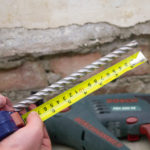How it Works - DryRod
Why Use DryRod Damp-Proofing Rods?

The Dryrod System developed by the makers of the leading Dryzone Damp Proofing Cream are even more effective and with guaranteed dosage and increased treatment speed are recommended for projects that demand maximum performance.
They are the quickest system available as the rods are simply inserted into pre-drilled 12mm holes along a continuous mortar course at 120mm centres. Perfect for DIY and an easy way to save $$$$.
As the latest development in the treatment of rising damp, there are numerous advantages to using Dryrod Damp-Proofing Rods:
- The most effective rising damp eradication treatment available — Independent testing proves that both Dryrod and Dryzone outperform all other competitors systems.
- The simplest and fastest system to install — Simply drill holes the lowest mortar course, insert a rod in each hole and you’re finished.
- No specialist equipment or expertise required — Only a standard hammer drill with a 12 mm masonry drill bit, rubber gloves and a sharp cutting tool such as garden secateurs are needed.
- Nothing to clean up — Each foil wrap packet when opened contains 10 rods which are inserted straight into the pre-drilled holes. Nothing to clean up.
- Correct amount applied every time. — Each rod contains exactly the correct amount of water-repellent guaranteeing no under treating and no wastage.
- The eradication of rising damp is permanent — The active ingredients permeate, and bond with the masonry providing a permanent solution to rising damp.
- Proven to work on the wettest walls (even up to 95% saturation) — Independent testing prove that the Dryrod system outperforms even our premium damp-proofing cream at high saturation levels.
- Safe and environmentally friendly — Dryrods are solvent free, non-caustic and odour free. They are safe for asthma sufferers and pet friendly! Bedrooms that have been treated can be slept in the same night.
Dryrod Application
 | Mark your drill bit to drill to within 10 mm of the far side of the wall you are treating. |  | Use the rotary hammer mode on your SDS drill. |
 | Drill into the lowest mortar course above ground/floor level at 120 mm centres. Reduce the pressure on the drill as you get to within 30 mm of the far side of the wall to prevent damage to the other side of the wall. |  | Make sure the hole is clear of debris by moving the drill bit back and forward. |
 | A Dryrod is 180 mm in length which is the exact length to treat a solid double brick wall. For single brick cut each rod in half using garden secateurs or similar sharp cutting tool. For 300 mm walls insert one and a half rods into each hole. Rods can be inserted from both sides of thicker walls. As long as they are in the same mortar course they need not be in line with each other. |  | Insert the rod into the hole recessed to approximately 10 mm from the face of the wall using the back of the drill bit. |
The active ingredients take approximately 7 days to diffuse forming a water repellent barrier which prevents further damp rising up the wall. The rod does not break down and remains in the wall. The holes can be plugged immediately for aesthetic reasons if not hidden by replacing skirting boards.
The Importance of Effectively Treating Rising Damp
Your home could well be your biggest investment and needs protecting. Rising Damp, like cancer in humans gets worse the longer it is left untreated therefore it is urgent to effectively treat the problem. Sanding back damaged walls and repainting will not cure the problem.
For this reason, Dryrod Damp-Proofing Rods have been designed to form an effective damp-proof course in walls of all types and have been tested under conditions of up to 95% saturation, where it has been shown to outperform all tested competitor products.
This is important because no two walls suffering from rising damp are the same. In particular the physical properties of the mortar used to construct walls can vary considerably and this can have a significant influence on the effectiveness of any rising damp treatment.
Naturally, homeowners want the most effective products available to be used to treat rising damp in their properties. Creating the best possible barrier to rising damp minimises moisture in the wall and blocks the build-up of ground salts.
Replastering
As with all remedial damp-proofing systems, it is necessary to remove and replace any salt-contaminated plaster with a render containing one of our recommended moisture barriers.
Further Technical Advice
If you have any further technical enquiries or have further questions about the installation process, please call 0402 278 053.